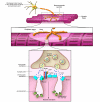Myasthenia gravis: past, present, and future
- PMID: 17080188
- PMCID: PMC1626141
- DOI: 10.1172/JCI29894
Myasthenia gravis: past, present, and future
Abstract
Myasthenia gravis (MG) is an autoimmune syndrome caused by the failure of neuromuscular transmission, which results from the binding of autoantibodies to proteins involved in signaling at the neuromuscular junction (NMJ). These proteins include the nicotinic AChR or, less frequently, a muscle-specific tyrosine kinase (MuSK) involved in AChR clustering. Much is known about the mechanisms that maintain self tolerance and modulate anti-AChR Ab synthesis, AChR clustering, and AChR function as well as those that cause neuromuscular transmission failure upon Ab binding. This insight has led to the development of improved diagnostic methods and to the design of specific immunosuppressive or immunomodulatory treatments.
Figures



References
-
- Robertson D.N. Enumerating neurology. Brain. 2000;123:663–664. - PubMed
-
- Marsteller H.B. The first American case of myasthenia gravis. Arch. Neurol. 1988;45:185–187. - PubMed
-
- Pascuzzi R.M. The history of myasthenia gravis. Neurol. Clin. 1994;12:231–242. - PubMed
-
- Keesey J.C. “Crisis” in myasthenia gravis: an historical perspective. Muscle Nerve. 2002;26:1–3. - PubMed
Publication types
MeSH terms
Substances
Grants and funding
LinkOut - more resources
Full Text Sources
Other Literature Sources
Medical
Miscellaneous

